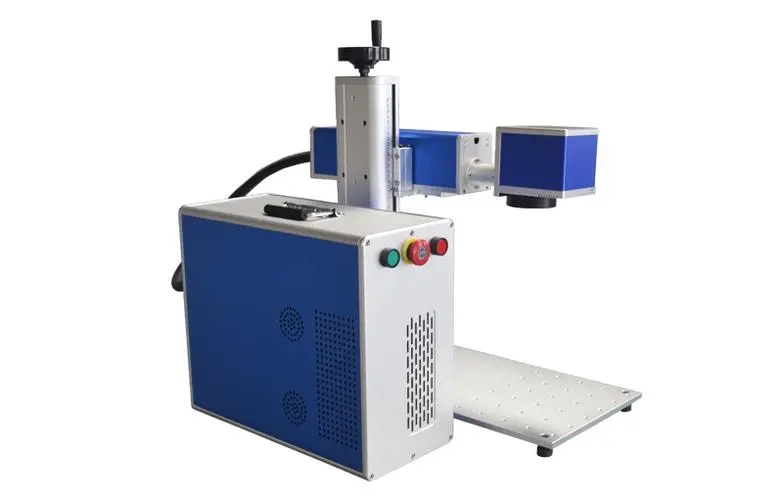The widely used laser marking models in the Chinese market currently include: optical fiber, ultraviolet, carbon dioxide, picosecond, femtosecond, and other types. However, optical fiber, ultraviolet, and carbon dioxide laser marking machines are currently the mainstream laser marking equipment on the market, covering almost all types of product identification and packaging applications. Their application differences are due to their development advantages in their respective fields, and the main difference is their different working principles and the composition and structure of their core components, Today, editor Ji Xiangyun will introduce the main differences between fiber optic laser marking machines and ultraviolet laser marking machines.
1. Core component laser
Optical fiber laser marking machine: a laser with a wavelength of 1064 nm is used.
Ultraviolet laser marking machine: 355 nm ultraviolet laser is used. Compared with infrared laser, the third order intracavity frequency doubling technology is used for ultraviolet, and the focus spot of 355 nm ultraviolet light is very small, greatly reducing the mechanical deformation of consumables and reducing the impact of processing thermal effects. Regarding laser wavelength, generally, the shorter the wavelength, the smaller the focus spot produced by the laser, and the higher the accuracy. During processing, the smaller the heat affected area formed by the lock, and the finer the processing effect.
2. Comparison of advantages between fiber laser marking machines and ultraviolet laser marking machines
(1) In terms of wavelength opposition, ultraviolet lasers have shorter wavelengths than visible light (visible to the naked eye), enabling more accurate focusing, while producing extremely fine circuit characteristics, while maintaining excellent positioning accuracy.
(2) The processing temperature of the workpiece is relatively low, and the high-energy photons present in ultraviolet light can easily be applied to the combination of large PCB circuit boards, ranging from standard materials such as FR4 to high-frequency ceramic composites and flexible circuit board materials including polyimide. The absorbance of common PCB materials under the action of six different lasers. The six lasers include excimer lasers (wavelength 248 nm), infrared lasers (wavelength 1064 nm), and two carbon dioxide lasers (wavelength 9.4 um and 1.06 um, respectively). Ultraviolet laser (ND: YAG, wavelength 355nm) is a relatively rare laser with the same absorption rate among the three materials.
(3) Ultraviolet laser marking machines exhibit extremely high absorptivity when applied to resin and copper materials, as well as suitable absorptivity when processing glass. The relatively expensive excimer laser (wavelength 248 nm) can only obtain better absorption when processing these materials. The differences in materials make UV lasers the best choice for PCB material applications in many industrial fields, ranging from the production of the most basic circuit boards, circuit wiring, to the production of extremely small embedded chips, and other processes.
Analysis of the difference between optical fiber laser marking machine and ultraviolet laser marking machine
Analysis of the difference between optical fiber laser marking machine and ultraviolet laser marking machine
3. Processing methods of fiber laser marking machine and ultraviolet laser marking machine
The process of ultraviolet laser processing belongs to cold processing, which generates less heat during processing. (UV) photons with high load energy can strike chemical components of materials or surrounding media. Causing non-thermal process damage to the material. It does not generate heat or thermal deformation on the surface layer and local area to be processed. It is very suitable for fine processing or processing with high precision requirements. An optical fiber laser marking machine is a device that uses a laser beam to lower the surface layer of material and evaporate it to reveal the material layer, or uses light energy to cause burning or chemical and physical changes in the material surface to mark marks. Display etched patterns, barcodes, text, logos, and other graphics, suitable for metal product processing and identification of some non-metallic materials.
4. Segmentation of application fields
Ultraviolet laser marking machine: used in the high-end market of ultra-fine processing. For example, packaging of pharmaceuticals, cosmetics, polymer materials, and packaging bottles are marked with fine effects and clear markings, which are difficult to erase. It is superior to ink jet printing for environmental protection. UV laser marking machine marking on flexible PCB boards, scribing, silicon crystal drilling, blind hole processing. With these advantages, UV laser marking machines are widely used in these products.
Optical fiber laser marking machine: Suitable for many metal surface markings and deep engraving. Due to the large amount of heat generated by the laser beam, optical fiber is not suitable for marking of special materials, but it has a high cost performance ratio.





